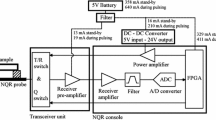Abstract
Magnetic resonance measurements in the field, such as for land mine detection using14N nuclear quadrupole resonance (NQR), must deal with large levels of environmental radio-frequency interference. One approach to minimize the level of interference which enters the NQR receiver is the use of a coil with no magnetic dipole moment. Such a coil is, ideally, sensitive only to spatial gradients of the magnetic fields and is referred to as a gradiometer. It is straightforward to estimate the amount of reduction one can expect for an ideal gradiometer. Here it is shown that for14N NQR land mine detection in practice, the ultimate level of interference received can be expected to be significantly greater than what one would expect solely due to these spatial gradients. This is due to the fact that it is quite difficult to construct an ideal gradiometer.
Similar content being viewed by others
References
Garroway A.N., Buess M.L., Miller J.B., Suits B.H., Hibbs A.D., Barrall G.A., Matthews R., Burnett L.J.: IEEE Trans. Geosci. Remote Sens.39, 1108–1118 (2001)
Suits B.H., Garroway A.N., Miller J.B.: J. Magn. Reson.131, 154–158 (1998)
Spaulding A.D., Washburn J.S.: Atmospheric Radio Noise: Worldwide Levels and Other Characteristics. NTIA Report 85-173, U.S. Dept. of Commerce, National Telecommunications and Information Administration 1985.
Spaulding A.D., Disney R.T.: Man-made Radio Noise, Part I: Estimates for Business, Residential, and Rural Areas, OT Report 74-38, U.S. Dept. of Commerce, Office of Telecommunications 1974.
Balanis C.A.: Antenna Theory: Analysis and Design, chap. 5. New York: Harper and Row 1982.
Howard W.: ITT Reference Data for Radio Engineers, 6th edn. Indianapolis: Sams & Co. 1975.
Katsube T.J., Klassen R.A., Das Y., Benn K., Best M.E., Ernst R. in Detection and Remediation Technologies for Mines and Minelike Targets VII (Broach J.T., Harmon R.S., Dobeck G.J., eds.), pp. 821–829. Bellingham, Wash.: SPIE — the International Society for Optical Engineering 2002 (Proceedings of the SPIE, vol. 4742)
Suits B.H., Garroway A.N., Miller J.B.: J. Magn. Reson.135, 373–379 (1998)
Maclean T.S.M., Wu Z.: Radiowave Propagation over Ground. London: Chapman and Hall 1993.
Pocklington H.C.: Cambridge Philos. Soc. Proc.9, 324–332 (1897)
Storer J.E.: Trans. Am. Inst. Electr. Eng.75, 606–619 (1956)
An L.N., Smith G.S.: Radio Sci.17, 483–502 (1982)
Chang D.C.: IEEE Trans. Antennas Propag.21, 871–874 (1973)
Cook B., Lowe I.J.: J. Magn. Reson.49, 346–349 (1982)
Suits B.H., Garroway A.N.: J. Appl. Phys.94, 4170–4178 (2003)
Author information
Authors and Affiliations
Corresponding author
Rights and permissions
About this article
Cite this article
Suits, B.H. The noise immunity of gradiometer coils for14N NQR land mine detection: Practical limitations. Appl. Magn. Reson. 25, 371–382 (2004). https://doi.org/10.1007/BF03166535
Received:
Revised:
Issue Date:
DOI: https://doi.org/10.1007/BF03166535




